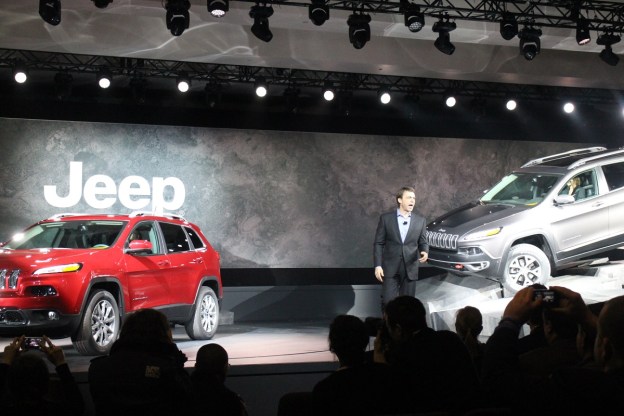
If you’re going to make an entrance, you’re better off making it a memorable one.
In fact, no other automaker has even come close to making quite the spectacle Jeep did during its press conference and subsequent unveiling of their much anticipated and somewhat controversial 2014 Cherokee. Jeep recreated the rocky terrain of Moab, Utah, on stage and drove two of its new Cherokees to the applause of the assembled automotive world’s scribes and photographers.

Speaking to the packed room of journalist, Jeep President and CEO Mike Manley introduced the world to reinvigorated 2014 Cherokee, a car that replaces the discontinued Liberty in Jeep’s mid-size SUV lineup.
It’s easy to get excited about the Cherokee’s almost out-of-this-world new looks. The design is equal parts aggressive with a brand new front fascia and windswept headlights.

Not everyone will take to the Cherokee’s modern interpretation, which is decidedly curvier than anything we’ve ever seen from the Jeep camp but we admit being smitten with its sleek new threads and progressive design.
Of course it’s easy to get carried away with the Cherokee’s new look, but we’re just as excited about its surprisingly robust tech suite and careful attention to the needs of the modern driver.

In addition to a new cargo management system located at the rear of the vehicle, which is essentially a series of molded trays and compartments for onboard cargo (think of it as an oversized picnic plate with specific sections for your potato salad and baked beans), Jeep has added a wireless charging pad, centrally located USB ports, and a dedicated space for mobile phones – a surprisingly often-overlooked feature in virtually all automobiles on the road today.
The 2014 Cherokee also packs a segment first: a configurable seven-inch LCD instrument cluster which provides information for real-time fuel economy and turn-by-turn navigation.

Additionally, drivers can add an 8.4-inch touchscreen display in the center console that integrates with Chrysler’s UConnect system, allowing for Bluetooth audio streaming through apps like Pandora and Slacker.
Jeep was also keen to point out a number of driver assistance tech including the tongue-twisting Park Sense active park assist system, which utilizes a number of ultrasonic sensors placed around the Cherokee and provides drivers with parallel and perpendicular parking assistance. With Jeep’s park assist, drivers are only responsible for throttle and brake controls. Hands off that steering wheel!

Of course, this being a Jeep, a great deal of emphasis was placed on the car’s off-road ability. Jeep says it has improved the vehicle’s ground clearance to encourage off-road jaunts.
The 2014 Cherokee will be available in four different model trims. On stage during the press conference were the Trailhawk and Limited, with Sport and Latitude models to follow.
Customers will be able to choose from two different engines: a 3.2 Pentastar V6 producing 271 hp and 239 lb.ft of torque, and a turbocharged 2.4-liter Tigershark Multiair good for 184 horses and 171 lb.ft of torque. Chrysler fans will undoubtedly recognize the turbocharged Tigershark as one of the engines offered in the 2013 Dodge Dart.
Pricing has yet to be confirmed, though Jeep says all four models of the 2014 Cherokee will start to appear in dealer showrooms during third quarter of this year.


